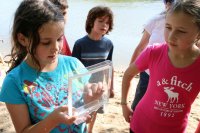Getting Started With Project-Based Learning (Hint: Don’t Go Crazy)
Your content has been saved!
Go to My Saved Content.Before the start of the school year, many of us want to use the remaining weeks of summer to learn some new skills -- such as project-based learning (PBL). One of the things we stress for new PBL practitioners is, as I say, "don't go crazy." It's easy to go "too big" when you first start PBL. I have heard from many teachers new to PBL that a large, eight-week integrated project was a mistake. So how do you start PBL in ways that will ensure your success as a learner and teacher? Here are a few tips to consider.
Start Small
As I said, "Don't go crazy!" Instead of targeting a million standards, focus on a few power standards. Concentrate the learning on one subject rather than multiple disciplines. PBL emphasizes in-depth inquiry over coverage. Leverage this principle in designing your first PBL project. Make sure that project won't take more than two to three weeks. Instead of doing real-life fieldwork, consider having the learning occur in the classroom. Ensure authenticity and public audience, but keep it focused.
Plan Now
One of the challenges of PBL, but also one of the joys, is the planning process. In PBL, you plan upfront. By using the backwards design process, you can effectively map out a project that's ready to go in the classroom. Once you plan it, you're free to differentiate instruction and meet the immediate needs of your students rather than being in permanent crisis-mode trying to figure what will happen tomorrow.
Limited Technology
We love technology, but sometimes we get too "tech happy." When first doing PBL, you should focus on mastering the design and implementation process; technology is another layer to the work that can complicate things. If you plan on using technology, stay limited in your choice. As you get begin to master PBL as a teacher, you can then use technology to manage the process. But as a PBL beginner, focus on the PBL process itself.
Know the Difference Between PBL and Projects
This is the big one! I can't stress this enough! With PBL, the project itself is the learning, not the "dessert" at the end. If you are doing projects in the classroom, you may or may not be doing PBL. In fact, many teachers think they are doing PBL, but are actually doing projects. Again, in PBL you are teaching through the project, not teaching and then doing the project. If you want a quick way to see if you're meeting the essential elements of PBL, I highly recommend the Buck Institute for Education's PBL Project Checklist. It helps to make sure that you are focusing on aspects such as inquiry, voice and choice, and significant content.
We are all learners, and when we start something new, we start small. We limit our focus to help us master the bigger thing step by step. Through mastery of manageable goals, you can be well on your way to becoming an advanced PBL practitioner. Since you are learning a new process, your students are learning one as well. They need a manageable experience just as you do! Start your own learning and planning process now in these last remaining weeks of summer so that you have time to unpack what PBL can mean for your teaching, and implement it in a manageable way for you and your students.
Photo credit: wwworks via Flickr (CC BY 2.0)
